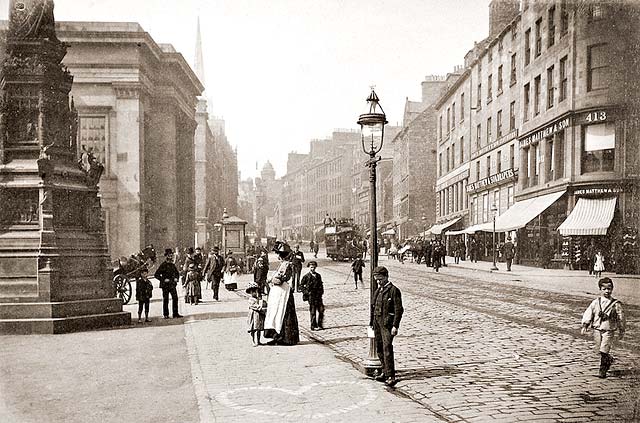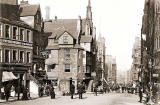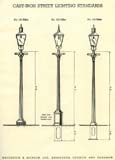|
High Street Part of Edinburgh's Royal Mile |
Looking west from beside St Giles' Church
© Reproduced with acknowledgement to Jan Weijers, Netherlands
|
High Street |
|
The Date? Thank you to Jan Weijers, Netherlands for allowing me to reproduce this photo and other old photos of Edinburgh. The photo above was taken by J Patrick. Would this have been John Patrick (1830-1923) or his son, James (b.1863)?
- John Patrick had photographic studios in Edinburgh,1884
to 1888 - John Patrick & Son had a studio in Edinburgh from 1890 to 1895. - John Patrick & Son had a studio in Edinburgh 1896 to 1912 . - James Patrick had studios in Edinburgh, 1895 to 1907. I've not yet fully researched the date of this photo, but it must have been taken in 1888 or later. (See 'Statue' paragraphs below.) Perhaps somebody else will be able to do a little research and let me know what they find. |
|
The View This photo was taken from the High Street, close to the NW corner of St Giles' church, looking up the High Street towards the junction with George IV Bridge and Bank Street. This junction is just behind the horse-drawn tram. Statue The bronze statue on the extreme-left and most of the buildings still look very similar today. The statue is to Walter Francis Montagu Douglass Scott, 5th Duke of Buccleuch and 7th Duke of Queensferry KG (1806-1884). He is remembered for the building of Granton Harbour on the Firth of Forth, three miles to the north of the centre of Edinburgh. The statue was unveiled on February 7, 1888 (so this helps to date the photograph above). In the Distance These can just be seen in the background, through the mist: - The tall spire of the Assembly Hall, now 'The Hub' Festival offices. - The Camera Obscura, close to Ramsay Lane and the Castle Esplanade. Heart of Midlothian The outline of the Heart of Midlothian, can be seen on the cobble stones in front of the old lamp post in the foreground. This heart-shape mosaic marks the position of the Old Tolbooth, built in the 15th century and demolished in 1817. The Old Tolbooth was Edinburgh's administrative centre, prison and one of the sites of public execution. Source: Wikipedia Wellhead Further down the road, in front of the next lamp post, the large, square, stone structure is a wellhead. It is one of four wellheads that can still be found in the Royal Mile. This page on thee Royal Mile web site has photos of one of these wellheads and a brief history of them. They were the only source of water for residents in Edinburgh Old Town until 1820. |
|
Reply 1. Steven Oliver Duns, Borders, Scotland |
|
High Street Thank you to Steven Oliver for commenting on the old lamp posts in these two photos. Both photos are of the High Street: - The first looks to the west, up the street, from St Giles' Church. - The second looks to the east, down the street, to John Knox House. Steven wrote: |
|
Lamp Posts "I'm not entirely sure of the make of lantern but I can identify the columns - they are Mackenzie Bros/Mackenzie & Moncur No.101s, identical to the two surviving examples in Forth Street." Steven Oliver, Duns, Borders, Scotland: February 10, 2011 |
|
An illustration of this No 101 column appears in the Mackenzie and Moncur street lighting catalogue. It is the left-hand illustration on the page below..
|



